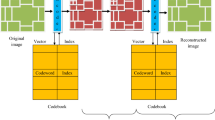Abstract
This paper proposes a modified video compression model that optimizes vector quantization codebook by using the adapted Quantum Genetic Algorithm (QGA) that uses the quantum features, superposition, and entanglement to build optimal codebook for vector quantization. A context-based initial codebook is created by using a background subtraction algorithm; then, the QGA is adapted to get the optimal codebook. This optimal feature vector is then utilized as an activation function inside the neural network’s hidden layer to remove redundancy. Furthermore, approximation wavelet coefficients were lossless compressed with Differential Pulse Code Modulation (DPCM); whereas details coefficients are lossy compressed using Learning Vector Quantization (LVQ) neural networks. Finally, Run Length Encoding is engaged to encode the quantized coefficients to achieve a high compression ratio. As individuals in the QGA are actually the superposition of multiple individuals, it is less likely that good individuals will be lost. Experiments have proven the system’s ability to achieve a higher compression ratio with acceptable efficiency measured by PSNR.
Access this chapter
Tax calculation will be finalised at checkout
Purchases are for personal use only
Similar content being viewed by others
References
Elmolla, A., Salama, G., Elbayoumy, D.: A novel video compression scheme based on fast curvelet transform. Int. J. Comput. Sci. Telecommun. 6(3), 7–10 (2015)
Shraddha, P., Piyush, S., Akhilesh, T., Prashant, K., Manish, M., Rachana, D.: Review of video compression techniques based on fractal transform function and swarm intelligence. Int. J. Mod. Phys. B 34(8), 1–10 (2020)
Ponlatha, S., Sabeenian, R.: Comparison of video compression standards. Int. J. Comput. Electr. Eng. 5(6), 549–554 (2013)
Knop, M., Cierniak, R., Shah, N.: Video compression algorithm based on neural network structures. In: Proceedings of the International Conference on Artificial Intelligence and Soft Computing, Poland, pp. 715–724 (2014)
Haiju, F., Kanglei, Z., En, Z., Wenying, W., Ming, L.: Subdata image encryption scheme based on compressive sensing and vector quantization. Neural Comput. Appl. 33(8), 1–17 (2020)
Zhang, J., Li, H., Tang, Z., Liu, C.: Quantum genetic algorithm for adaptive image multi-thresholding segmentation. Int. J. Comput. Appl. Technol. 51(3), 203–211 (2015)
Mousavi, S., Afghah, F., Ashdown, J.D., Turck, K.: Use of a quantum genetic algorithm for coalition formation in large-scale UAV networks. Ad Hoc Netw. 87(1), 26–36 (2019)
Tian, Y., Hu, W., Du, B., Hu, S., Nie, C., Zhang, C.: IQGA: a route selection method based on quantum genetic algorithm-toward urban traffic management under big data environment. World Wide Web 22(5), 2129–2151 (2019)
Atheeshwar, M., Mahesh, K.: Efficient and robust video compression using Huffman coding. Int. J. Adv. Res. Eng. Technol. 2(8), 5–8 (2014)
Suri, A., Goraya, A.: Hybrid approach for video compression using ant colony optimization and modified fast Haar wavelet transform. Int. J. Comput. Appl. 97(17), 26–30 (2014)
Rubina, I.: Novel method for fast 3d DCT for video compression. In: International Conference on Creativity in Intelligent Technologies and Data Science, Russia, pp. 674–685 (2015)
Esakkirajan, S., Veerakumar, T., Navaneethan, P.: Adaptive vector quantization based video compression scheme. In: IEEE International Conference on Signal Processing and Communication Technologies, India, pp. 40–43 (2009)
Nithin, S., Suresh, L.P.: Video coding on fast curvelet transform and burrows wheeler transform. In: IEEE International Conference on Circuit, Power and Computing Technologies, India, pp. 1–5 (2016)
Boufares, O., Aloui, N., Cherif, A.: Adaptive threshold for background subtraction in moving object detection using stationary wavelet transforms 2D. Int. J. Adv. Comput. Sci. Appl. 7(8), 29–36 (2016)
Wang, W., Yang, S., Tung, C.: Codebook design for vector quantization using genetic algorithm. Int. J. Electron. Bus. 3(2), 83–89 (2005)
Singh, A.V., Murthy, K.S.: Neuro-curvelet model for efficient image compression using vector quantization. In: International Conference on VLSI Communication Advanced Devices Signals and Systems and Networking, India, pp. 179–185 (2013)
Author information
Authors and Affiliations
Corresponding author
Editor information
Editors and Affiliations
Rights and permissions
Copyright information
© 2021 The Editor(s) (if applicable) and The Author(s), under exclusive license to Springer Nature Switzerland AG
About this paper
Cite this paper
Hassan, O.F., Darwish, S.M., Khalil, H.A. (2021). A Context-Based Video Compression: A Quantum-Inspired Vector Quantization Approach. In: Hassanien, A.E., Slowik, A., Snášel, V., El-Deeb, H., Tolba, F.M. (eds) Proceedings of the International Conference on Advanced Intelligent Systems and Informatics 2020. AISI 2020. Advances in Intelligent Systems and Computing, vol 1261. Springer, Cham. https://doi.org/10.1007/978-3-030-58669-0_1
Download citation
DOI: https://doi.org/10.1007/978-3-030-58669-0_1
Published:
Publisher Name: Springer, Cham
Print ISBN: 978-3-030-58668-3
Online ISBN: 978-3-030-58669-0
eBook Packages: Intelligent Technologies and RoboticsIntelligent Technologies and Robotics (R0)




